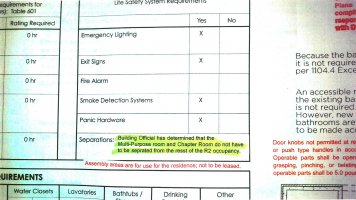Brooke Dixon
REGISTERED
Hi, we are working on a project right now that is currently classified as "B" for business use.
But part of the building is being leased to a business that offers coworking space/shared office space and is beginning to book events such as wedding receptions.
Are we going to need to reclassify the space from B to A-2 or A-3? If so, we are worried about having to install a sprinkler system.
Details:
The building has full occupancy right now with all businesses using it for office space.
The "Acme cowork" business now has 6,000 sq feet rented and uses it mostly for selling cowork memberships/monthly fees to people who use it 24/7 for shared office space.
The cowork has a kitchen but no stove. The cowork does not have a restaurant license and does not sell food.
90% of the time Acme is using the space for coworking/office space.
The other 10% of the time it's getting booked for wedding receptions, birthday parties, bridal showers etc. It's BYOB and the event client chooses their own local catering company to bring in the food.
For sales figures, Acme earns 75% of its sales from coworking memberships and 25% from event space bookings.
The main event space is 2,000 sq feet and can do 125 seated guests for dinner and 200 for cocktail receptions.
My questions are:
1. Can Acme keep the current "B" classification since most of the time it's still being used for normal business office space?
2. If we need to move them to an "A" classification, would they be "A-2" or "A-3" ? I am wondering if they would fit under "A-3" because maybe they could be considered a "Dance Hall" under A-3. My understanding is that "A-2" is more for restaurants and Acme is not a restaurant.
3. Acme is moving into the category of a lot of the BYOB barn venues that you see offering wedding receptions. What would they be considered? A-2 or A-3?
Thanks in advance for any help you can provide. Very confused.
But part of the building is being leased to a business that offers coworking space/shared office space and is beginning to book events such as wedding receptions.
Are we going to need to reclassify the space from B to A-2 or A-3? If so, we are worried about having to install a sprinkler system.
Details:
- Building sq feet = 20,000
- Rentable sq feet = 15,000
- 3 story building from 1800's on National Historic Registry
- No tenants or areas of the building have a sprinkler system at this time
The building has full occupancy right now with all businesses using it for office space.
The "Acme cowork" business now has 6,000 sq feet rented and uses it mostly for selling cowork memberships/monthly fees to people who use it 24/7 for shared office space.
The cowork has a kitchen but no stove. The cowork does not have a restaurant license and does not sell food.
90% of the time Acme is using the space for coworking/office space.
The other 10% of the time it's getting booked for wedding receptions, birthday parties, bridal showers etc. It's BYOB and the event client chooses their own local catering company to bring in the food.
For sales figures, Acme earns 75% of its sales from coworking memberships and 25% from event space bookings.
The main event space is 2,000 sq feet and can do 125 seated guests for dinner and 200 for cocktail receptions.
My questions are:
1. Can Acme keep the current "B" classification since most of the time it's still being used for normal business office space?
2. If we need to move them to an "A" classification, would they be "A-2" or "A-3" ? I am wondering if they would fit under "A-3" because maybe they could be considered a "Dance Hall" under A-3. My understanding is that "A-2" is more for restaurants and Acme is not a restaurant.
3. Acme is moving into the category of a lot of the BYOB barn venues that you see offering wedding receptions. What would they be considered? A-2 or A-3?
Thanks in advance for any help you can provide. Very confused.

